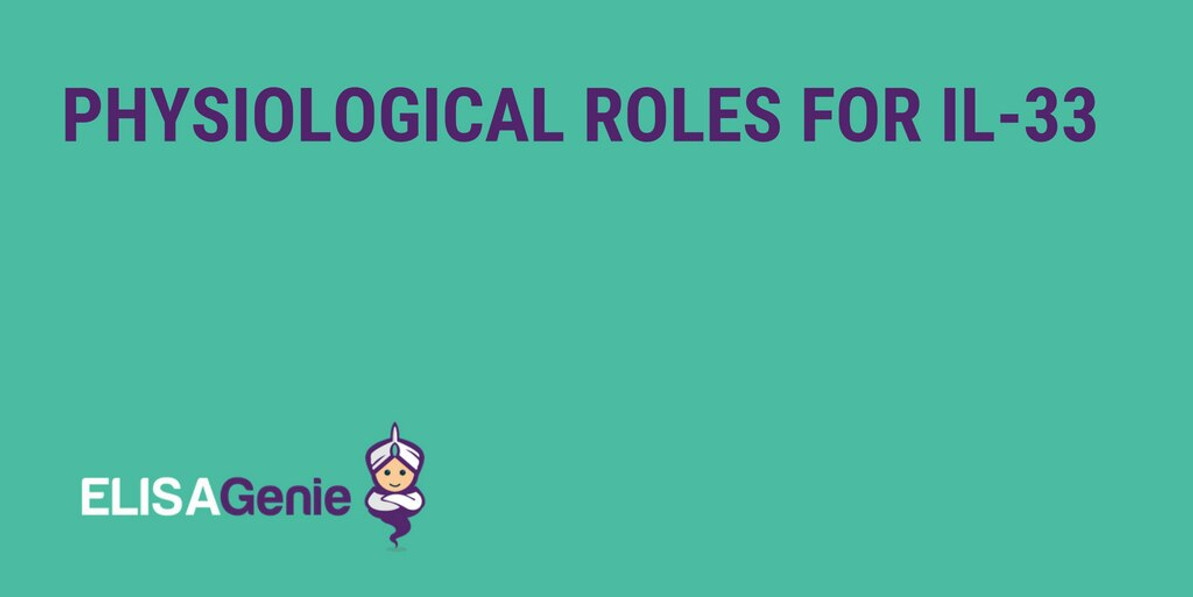Physiological Roles for IL-33 | Assay Genie
By Charlotte O'Donnell PhD
A role for IL-33 in Barrier Function and Epithelial Wound Healing
IL-33 is constitutively expressed by cells involved in the maintenance of mechanical barriers, including keratinocytes, lung and gut epithelial cells, fibroblasts and smooth muscle cells [1]. In these cells IL-33 is localized to the nucleus and mediates gene transcription. It is believed to maintain a quiescent state as it is only produced in barrier cells when they are senescent. Indeed, downregulation of IL-33 has been linked to the initiation of cellular proliferation in barrier cells. Once a barrier is breached, nuclear IL-33 is released and functions as an “alarmin” or damage associate molecular pattern (DAMP). This extracellular IL-33 binds to ST2L expressing cells, such as mast cells, DCs, macrophages or group 2 innate lymphoid cells to activate a primary acute immune response.
Th2 and mast cells constitutively express ST2L on the surface and rapidly respond to IL-33. Mast cells secrete pro-inflammatory cytokines, typically resembling a Th2 response (i.e. IL-4 and IL-5), thus promoting the migration of basophils and eosinophils to the site of the barrier breach. Proteases are also secreted which disrupt connective tissue to allow the influx of immune cells. These enzymes cleave the full-length IL-33 alarmin into N-terminally truncated forms, which can amplify the bioactivity up to 30-fold. Activated mast cells also actively secrete IL-33, leading to high local levels of IL-33.
Barrier Function
At the same time, recent data has shown IL-33 can trigger wound healing responses, to rapidly repair the damaged barrier by directly activating surrounding fibroblasts. DCs are activated in this inflammatory environment and phagocytose pathogens. The pathogenic antigens are transported to nearby lymph nodes to activate naïve T helper cells, thus activating the appropriate immune response. Eventually, IL-33 bioactivity is extinguished upon destruction of the IL-1 family core structure, by chymase produced by activated mast cells [2].
Consistent with its role in maintaining barrier function, IL-33 is emerging as a significant mediator of colonic mucosal wound healing. Indeed, administration of IL-33 was shown to promote wound healing in a surgical incision model by increasing re-epithelialisation and extracellular matrix (ECM) deposition. Following damage to the intestinal barrier, an initial inflammatory phase occurs. IL-33 is significantly upregulated during this phase. The increased levels of which activate local innate immune cells. Subsequently, a proliferative phase occurs, during which collagen is laid down and angiogenesis occurs. This is followed by a remodelling stage. During this time, inflammation is reduced and intestinal homeostasis is re-established. Finally, fibrosis takes place [3].
The role of IL-33/ST2 in immune cells
Given the high level of expression of ST2 on Th2 cells, a vast amount of literature has explored the role of IL-33/ST2 signalling in these cells and the effects of this pathway on the cell populations. ST2L modulates effector functions in infectious, allergic and autoimmune disorders. ST2L is expressed by polarized Th2 cells and can induce production of Th2 cytokines such as IL-4, IL-5 and IL-13. This is in contrast to Th1 cells, which produce mainly IFN-gamma, IL-2 or TNF-Beta. Treatment of mice with recombinant IL-33 induced a Th2-mediated immune response. Increased IL-5, IgE and eosinophil recruitment was also observed, accompanied by goblet cell hyperplasia and increased mucus production [4].
Innate Lymphoid cells
Recently innate lymphoid cell (ILC) populations have been shown to strongly express ST2 and as such, much recent focus concerns this pathway in ILC2s. Increased ILC populations are found at barrier surfaces such as the skin, lung and gut. ILCs are involved in regulating the immune response from initiation to resolution of inflammation. These cells produce many pro-inflammatory and immunoregulatory cytokines in response to cytokine or microbial stimuli. This cell population can be divided into three groups depending on their expression of surface markers, transcription factors and cytokines. Group 2 ILCs (ILC2s) respond to IL-33, as well as thymic stromal lymphopoietin (TSLP) and IL-25. In the lung, following damage to the epithelial barrier, the ‘alarmin’ IL-33 is released and ILC2s become activated. Depletion of ILC2s in mice reduced repair of the airway epithelium in influenza infected mice. [5]. In an intestinal murine model, ILC2s were shown to support eosinophil development and survival in the intestine via IL-5 production. These cells also modulate tissue-resident eosinophils by secretion of IL-13 and subsequent eotaxin production. As well as regulating innate immunity, ILCs have also been implicated in the regulation of adaptive immunity, as studies have suggested that ILC2s may be involved in crosstalk with other cells expressing ST2L, such as T-regs [6].
References
- Martin, N.T. and M.U. Martin, Interleukin 33 is a guardian of barriers and a local alarmin. Nat Immunol, 2016. 17(2): p. 122-131.
- Haraldsen, G., et al., Interleukin-33 – cytokine of dual function or novel alarmin? Trends Immunol, 2009. 30: p. 227 – 233.
- Roy, A., et al., Mast cell chymase degrades the alarmins heat shock protein 70, biglycan, HMGB1, and interleukin-33 (IL-33) and limits danger-induced inflammation. J Biol Chem, 2014. 289(1): p. 237-50.
- Yin, H., et al., IL-33 accelerates cutaneous wound healing involved in upregulation of alternatively activated macrophages. Mol Immunol, 2013. 56(4): p. 347-53.
- Palmer, G. and C. Gabay, Interleukin-33 biology with potential insights into human diseases. Nat Rev Rheumatol, 2011. 7(6): p. 321-9.
- Monticelli, L.A., et al., Innate lymphoid cells promote lung tissue homeostasis following acute influenza virus infection. Nature immunology, 2011. 12(11): p. 1045-1054.
- Schiering, C., et al., The alarmin IL-33 promotes regulatory T-cell function in the intestine. Nature, 2014. 513(7519): p. 564-8
Recent Posts
-
Illuminating the Multifaceted Role of Acetylation: Bridging Chemistry and Biology Introduction:
Acetylation, a chemical process characterized by the addition of an acetyl functional group t …16th Apr 2024 -
Understanding IgA Test: Importance, Procedure, and Interpretation
The IgA test, also known as immunoglobulin A test, is a diagnostic tool used to measure the l …15th Apr 2024 -
Biomarker Testing: Advancements, Applications, and Future Directions
Biomarkers, measurable indicators of biological processes or responses to therapeutic interve …14th Apr 2024




